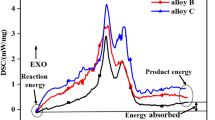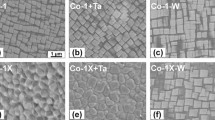Abstract
Previous studies revealed that initial sample thickness affects the growth rate of oxide scales formed during 800 or 900 °C air exposure. The effect is partially related to differences in depletion of minor alloying additions such as Mn, Ti, La in thick and thin specimens. However, it has previously been proposed that the specimen thickness dependence is partially governed by differences in creep strength of thick and thin substrates. To investigate this hypothesis, discontinuous air oxidation experiments were carried out with the Laves phase strengthened ferritic steel Crofer 22 H at 800 °C. Comparing the data for solution annealed and pre-aged (500 h, 900 °C) materials it could be shown that intrinsic creep strength of the alloy substantially affects oxidation rates. The observations can qualitatively be explained by assuming the relaxation of oxide growth stresses by plastic deformation of the metallic substrate to be an important parameter affecting the kinetics of oxide scale growth.









Similar content being viewed by others
References
P. Kofstad and R. Bredesen, Solid State Ionics 52, 69 (1992).
W. J. Quadakkers, H. Greiner, W. Köck, in Proceedings 1st European Solid Oxide Fuel Cell Forum, eds. U. Bossel (Baden, Switzerland, 1994), p. 525.
W. J. Quadakkers, J. Piron-Abellan, V. Shemet and L. Singheiser, Materials at High Temperatures 20, 115 (2003).
J. Piron-Abellan, V. Shemet, F. Tietz, L. Singheiser, and W.J. Quadakkers, Proceedings The Electrochemical Society 16, 811 (2001).
R. Hojda, W. Heimann, and W.J. Quadakkers, ThyssenKrupp Techforum, 20, (2003).
Web site http://www.thyssenkrupp-vdm.com/downloads/materialdatenblaetter.html?L=1.
P. Huczkowski, S. Ertl, N. Christiansen, T. Höfler, V. Shemet, L. Singheiser and W. J. Quadakkers, Materials at High Temperatures 22, 79 (2005).
P. Huczkowski, and W. J. Quadakkers, Effect of geometry and composition of Cr steels on oxide scale properties relevant for interconnector applications in solid oxide fuel cells (SOFCs), Vol. 65 (Report Forschungszentrum Juelich, Energy Technology, 2007) ISBN 978-3-89336-484-8.
J. Froitzheim, G. H. Meier, L. Niewolak, P. J. Ennis, H. Hattendorf, L. Singheiser and W. J. Quadakkers, Journal of Power Sources 178, 163 (2008).
B. Kuhn, C. Asensio Jimenez, L. Niewolak, T. Hüttel, T. Beck, H. Hattendorf, L. Singheiser and W. J. Quadakkers, Materials Science and Engineering A 528, 5888 (2011).
L. Singheiser, P. Huczkowski, T. Markus, and W. J. Quadakkers, High Temperature Corrosion Issues for Metallic Materials in Solid Oxide Fuel Cells, Shreir’s Corrosion, 2010, Chapter 1.19, pp. 482–517.
J. Zurek, D. J. Young, E. Essuman, M. Hänsel, H. J. Penkalla, L. Niewolak and W. J. Quadakkers, Materials Science and Engineering A 477, 259 (2008).
J. Zurek, G. H. Meier, E. Essuman, M. Hänsel, L. Singheiser and W. J. Quadakkers, Journal of Alloys and Compounds 467, 450 (2009).
J. Froitzheim, Ferritic steel interconnects and their interactions with Ni base anodes in solid oxide fuel cells (SOFC). 2008, PhD thesis, RWTH: Aachen, Germany, 2008, Report Forschungszentrum Jülich, Energy & Environment, vol. 16, ISBN 978-3-89336-540-1.
J. E. Hammer, S. J. Laney, R. W. Jackson, K. Coyne, F. S. Pettit, G. H. Meier, Oxidation of Metals, 67, 1 (2007).
L. Niewolak, Forschungszentrum Jülich, 2011, unpublished results.
P. Huczkowski, N. Christiansen, V. Shemet, J. Piron-Abellan, L. Singheiser and W. J. Quadakkers, Materials and Corrosion 55, 825 (2004).
P. Huczkowski, N. Christiansen, V. Shemet, J. Piron-Abellan, L. Singheiser and W. J. Quadakkers, Journal of Fuel Cell Science and Technology 1, 30 (2004).
Y. T. Chiu and C. K. Lin, Journal of Power Sources 198, 149 (2012).
R. W. Evans and B. Wilshire, Introduction to Creep, (The Institute of Materials, London, 1985).
Acknowledgments
The authors are grateful to Mr. H. Cosler, Ms. A. Kick and Mr. R. Mahnke for carrying out the oxidation tests, Mr. V. Gutzeit and Mr. J. Bartsch for optical microscopy, Dr. E. Wessel and Dr. D. Grüner for SEM investigations.
Author information
Authors and Affiliations
Corresponding author
Rights and permissions
About this article
Cite this article
Asensio-Jimenez, C., Niewolak, L., Hattendorf, H. et al. Effect of Specimen Thickness on the Oxidation Rate of High Chromium Ferritic Steels: The Significance of Intrinsic Alloy Creep Strength. Oxid Met 79, 15–28 (2013). https://doi.org/10.1007/s11085-012-9323-5
Received:
Published:
Issue Date:
DOI: https://doi.org/10.1007/s11085-012-9323-5




